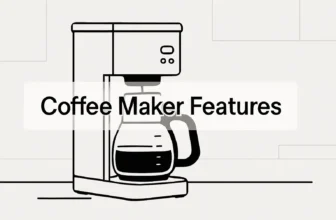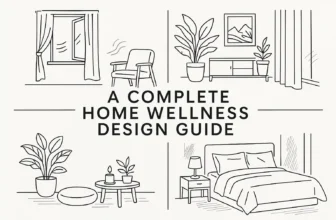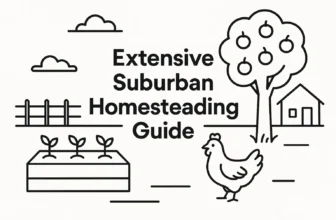A garden shouldn’t feel like a second job. With a few smart choices—like the right plants, surfaces, and watering systems—you can cut down on upkeep and still enjoy the space.
This article walks through the benefits of low-maintenance design, how to plan for it, and 15 specific ideas to make your yard simpler to manage. It also covers ongoing maintenance tips, what mistakes to avoid, and answers to common questions.
Table of Contents

Planning Your Low-Maintenance Backyard Garden
Smart planning cuts down on work later. Before planting or buying materials, it helps to figure out how you want the space to function and how much effort you’re willing to put in. A clear plan early on can prevent guesswork and unnecessary changes later.
Start by answering a few basic questions:
- How much time are you really willing to spend each week?
If the answer is “not much,” that’s perfectly fine—but it shapes your choices.
- What kind of weather do you get?
Sun, rain, soil type, and temperature shifts all matter. Local plants are usually better suited and don’t need much help to survive.
- What do you actually want to use the yard for?
Reading? Entertaining? Letting kids run around? Knowing this helps shape the layout.
Once you’ve worked that out, sketch a rough layout. You might want zones—a section for plants, another for gravel or a small patio, and maybe a spot covered with mulch or ground cover. The simpler the design, the less edge work or cleanup you’ll deal with later.
Another key point: group plants by how much water and sun they need. Mixing drought-tolerant shrubs with thirsty herbs usually leads to one side suffering. Keep like with like—it’s easier on you and the plants.
Finally, think ahead. Stone, gravel, or brick tends to hold up much longer than bark chips or cheap edging. Spend a bit more upfront if you can—it saves time and effort down the road.
15 Ideas for Creating a Low-Maintenance Backyard Garden
Once the planning is done, it’s time to start building a space that won’t need constant care. Below are 15 ways to simplify your garden without giving up function or style.
1. Plant Native Species
Plants that naturally grow in your region already know how to handle the local weather, soil, and pests. That means less watering, less feeding, and fewer problems. They’re often the most reliable long-term choice.
Look for plants recommended by local extension services or native plant societies. They typically need less fertilizer and are more resistant to common diseases in your area.
2. Use Perennials Instead of Annuals
Annuals need to be replanted every season. Perennials come back on their own—year after year. This one change can cut down planting time by half or more.
Try low-growing varieties for borders or use taller ones to fill out larger beds. Many perennials also spread slowly over time, helping to fill in gaps without needing constant attention or replacement.
3. Install Stone or Wood Pathways
Gravel, pavers, flagstone, and pressure-treated wood make solid surfaces that don’t need much upkeep. They:
- Suppress weed growth
- Don’t need mowing or trimming
- Help define walking areas clearly
In addition to being low-care, these materials improve drainage and reduce mud buildup during rain. Keep the path width consistent with how the space is used to prevent overgrowth at the edges.
4. Apply Mulch Generously
A thick layer of mulch helps with everything—weed control, soil temperature, and moisture retention.
Use 2–4 inches around plants and trees. Organic mulches like bark or shredded leaves break down slowly and feed the soil, too. Just keep it a few inches away from plant stems to prevent rot. Reapply mulch once or twice a year, depending on how quickly it decomposes in your climate.
5. Use Large Planters
Smaller pots dry out quickly and need constant watering. Larger ones hold moisture longer and allow more root growth.
They also reduce clutter—fewer containers, fewer surfaces to clean, and fewer dead plants to replace. Choose lightweight materials like resin or fiberglass if moving the planters is necessary. Make sure they have proper drainage holes to prevent root rot.
6. Set Up a Drip Irrigation System

This is one of the biggest time-savers. A simple drip system gets water straight to the base of each plant, exactly where it’s needed. It avoids overwatering, cuts down waste, and works well with timers.
Even basic kits can be set up in an afternoon. Most systems are expandable, so you can add more lines if you change your layout or plant new beds.
7. Grow Ground Covers
Skip the high-maintenance lawn in some spots. Ground covers like creeping thyme, ajuga, or sedum spread out and block weeds while staying low to the ground.
They don’t need mowing; once established, many require minimal watering. Look for varieties that match your light and soil conditions to help them settle in faster and stay dense enough to prevent weed growth.
8. Try Self-Watering Pots
These pots and planters have a water reservoir at the bottom. Moisture slowly moves up through the soil using capillary action, so the roots only take what they need—no more guessing or overcorrecting.
They’re especially useful for smaller edibles or ornamentals on patios and balconies. In hot weather, most can keep plants hydrated for several days. During cooler months, you might only need to refill once a week. Look for versions with a water level indicator to make refills easier.
9. Choose Drought-Tolerant Plants
Some plants survive long, dry spells without issue. A few examples are lavender, sedum, salvia, and blue fescue. They don’t wilt at the first sign of heat and rarely suffer from root rot.
Many of them are also low-feeding and don’t demand rich soil. Once established, they may only need deep watering once every 10–14 days, depending on climate. These plants work best in full sun and well-drained soil, so plan your placement accordingly.
10. Incorporate Hardscape Elements
Non-living features like gravel, concrete pavers, and patios don’t need water or trimming. They take up space, add structure, and reduce the square footage available for weeds to spread.
Consider using hardscapes to break up planting areas or connect spaces. A gravel bed with a bench might serve as a quiet reading spot. Stone edging also helps contain mulch or soil. Go for materials that last through multiple seasons with little maintenance—no sealing or power washing every few months.
11. Grow Easy Edibles
Some edible plants require minimal care and still produce well. Herbs like thyme, rosemary, sage, and mint are examples. Leafy crops like kale, collards, and Swiss chard are also fairly hands-off once they get started.
Stick to compact or bush varieties where possible—they’re easier to manage in small spaces. Most don’t need daily watering if the soil holds moisture well. Raised beds or deep pots with good drainage will help you avoid waterlogged roots and reduce weed pressure.
12. Add a Low-Maintenance Water Feature
It doesn’t have to be a complex setup. A small, solar-powered bubbler placed in a stone bowl can add movement and sound without turning into another thing you have to babysit.
Look for units that recirculate the same water and don’t require permanent plumbing. The motion helps prevent mosquitoes from laying eggs, and you won’t have to deal with clogged filters every week. Avoid models with standing water in shaded areas—algae builds up fast there.
13. Use Vertical Gardens or Wall Planters

Vertical growing systems save ground space and limit weed growth. They can also be easier to reach, especially for people who want to avoid crouching or kneeling for long periods.
Some models have built-in irrigation or allow for drip lines to be attached. Use them to grow herbs, greens, or shallow-rooted flowers. Lightweight soil and moisture-retaining materials help keep watering consistent. Just make sure your support surface—fence, wall, or frame—can carry the weight when fully planted.
14. Replace Some Lawn with Artificial Grass
Lawns take time. Artificial turf doesn’t. It cuts out mowing, watering, edging, and patching—all tasks that add up across the year.
Quality turf has improved a lot in texture and appearance. Some versions even include built-in drainage layers and antimicrobial coatings. It’s not zero-maintenance—you’ll still need to remove leaves, rinse it off occasionally, and brush high-traffic areas—but it’s far less involved than a living lawn.
15. Build Raised Garden Beds
Raised beds give you full control over the soil and reduce problems like compaction and poor drainage. You also get better control of weeds and fewer bending-heavy tasks.
Use long-lasting materials like cedar, composite boards, or galvanized metal. Beds that are 3–4 feet wide are easiest to work in—wide enough for plenty of planting space but narrow enough to reach the middle from both sides. If burrowing animals are an issue in your area, consider lining the bottom with hardware cloth.
Benefits of a Low-Maintenance Garden
Keeping a garden manageable doesn’t mean giving up on design or use. It just means setting it up in a way that cuts down daily work without turning the space into a chore.
Here’s what that can mean in practice:
- Less time doing routine tasks
Mowing every weekend? Skipping that. Replanting annuals every season? Not necessary. Most of the effort happens at the beginning.
- Fewer expenses over time
Once the garden is in place—with long-living plants and solid materials—it costs less to maintain.
- Minimal chemical use
Hardy and native plants usually hold their own. Pest problems and disease are less common when plants are suited to the climate.
- Lower water use
Drought-tolerant varieties and drip systems keep plants alive without using your watering cans daily.
- Less physical strain
No constant lifting, kneeling, or digging. This makes upkeep more manageable for more people.
- Fewer surprises season to season
You’re not constantly dealing with dead patches, overgrowth, or weeds spreading everywhere.
- More environmentally sound
Local plants and water-saving setups reduce waste and help support nearby ecosystems.
Maintenance Tips and Best Practices
Even a garden built for minimal upkeep benefits from a few consistent routines. These practices help prevent long-term issues and reduce the chance of needing major fixes later.
Water Deeply, Not Frequently
Instead of watering a little every day, soak the soil thoroughly once or twice a week. This helps plants grow deeper roots, making them more drought-tolerant. Shallow watering leads to weaker root systems and more frequent dry-outs.
Prune Selectively
Cut back only what’s needed. Remove dead, damaged, or overcrowded growth to keep plants healthy and well-shaped. Use clean, sharp tools and make cuts at natural branching points. Avoid over-pruning, which can stress the plant or lead to sunburned stems.
Monitor for Pests and Disease
Even hardy plants can run into trouble. Look for signs like leaf spots, wilting, or insect damage. Check under leaves and around stems regularly. Catching problems early often means a quick manual fix—no need for sprays or treatments unless the issue spreads.
Fertilize Based on Soil Needs
Before adding anything to your soil, test it. Many low-maintenance plants do fine in average soil and don’t need constant feeding. If nutrients are lacking, slow-release or organic fertilizers work best and won’t encourage fast, weak growth that needs more trimming.
Weed Before They Settle
Weeds are easiest to remove when they’re small. A quick check every week or so can stop them from taking hold. Hand-pull or use a hoe while the soil is damp—it’s faster and avoids deep-rooted growth. Preventative steps like dense planting also help.
Maintain Hardscape Features
Keep an eye on patios, stone borders, and paths. Sweep off debris, reset any loose stones, and check for drainage issues. Clean surfaces occasionally to prevent slipping hazards or algae growth, especially in shaded or damp spots.
Adjust Tasks With the Seasons
Your time in the garden will vary across the year. Spring might call for planting and light pruning. Summer tends to require monitoring for pests and checking watering systems. Fall is for cleanup and soil prep. Winter’s good for tool care and planning.
Keep a Simple Record
Jot down planting dates, what worked, what didn’t, and when you last fertilized or pruned. It doesn’t have to be detailed. Even basic notes help you avoid repeating mistakes and plan smarter for next year.
Common Mistakes to Avoid
A low-maintenance garden can still end up demanding more effort than it should—mainly due to decisions made during setup. These are the kinds of missteps that tend to complicate things over time.
Prioritizing Looks Over Function
That plant with dramatic blooms or the sleek metal edging might look great—at first. But if it doesn’t suit your climate or ends up needing constant attention, it becomes a liability. Choose elements that do the job well, not just ones that stand out.
Using the Wrong Materials for the Climate
Some materials simply don’t hold up in certain conditions. Wood can warp or rot in humid areas. Gravel might wash out in heavy rains. Painted metal often rusts near coastal air. Always check how something performs over time where you live—not just how it looks fresh out of the package.
Overcomplicating the Layout
Narrow beds, oddly shaped planting zones, and curving borders look nice in a sketch. In practice, they create more edge work and awkward corners to manage. A simple grid or zoned layout tends to hold up better—especially when it’s time to weed or water.
Not Allowing Enough Access
If you can’t reach the center of a bed without stepping in it, something’s off. Paths that are too tight or beds that are too deep make even quick tasks more time-consuming. Leave room to move easily—both now and later, when plants fill in.
Installing Features That Are Fussy to Maintain
It’s easy to underestimate the upkeep associated with certain add-ons. Some lighting systems require specific bulbs or wiring work, and certain fountains require regular cleaning and part replacements. If a feature isn’t easy to clean or fix with basic tools, skip it.
Underestimating Plant Growth
That neat little shrub? It may triple in size by next summer. Planting too close together leads to crowding, extra trimming, and sometimes the need to dig things out and start over. Always check mature height and width—not just how it looks at the nursery.
Conclusion
A backyard garden doesn’t need to be a constant project. With the proper setup, it can take care of itself for the most part—leaving you with more time to enjoy it.
Start simple. Use plants that can handle the conditions you already have. Avoid complicated layouts. Choose materials that last. And think ahead—not just about how things will look this season, but how much work they’ll need next year.
Low maintenance doesn’t mean there is no work at all. But it does mean fewer hours spent fixing problems or replacing plants that didn’t hold up.
FAQs
How do I start a low-maintenance garden from scratch?
Assess the sun, soil, and space. Use simple layouts, native plants, mulch, and efficient watering to keep upkeep minimal.
What are the best plants for a low-maintenance garden?
Native perennials, ornamental grasses, succulents, and drought-tolerant shrubs require little watering, pruning, or pest control.
Do I have to get rid of all my lawn?
No—just reduce the lawn size. To lower maintenance needs, replace sections with gravel, mulch, or ground cover.
How often should I water a low-maintenance garden?
Usually once or twice a week. Deep watering is better than frequent shallow watering for root strength.
Can I still grow food in a low-maintenance garden?
Yes. Choose herbs, leafy greens, and compact vegetables. For easier control, use raised beds or large containers.
This content is generated by AI, reviewed by our editorial team, and features products that have been thoroughly evaluated and chosen.





